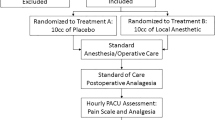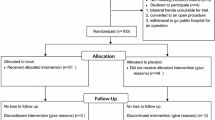Abstract
Background
Laparoscopic total extraperitoneal (TEP) inguinal hernioplasty is significantly less painful than open repair, but it is not completely painless. Local anesthetics are thought to decrease postoperative pain when placed at the surgical site. We conducted a systematic review of randomized controlled trials (RCTs) to evaluate the efficacy of extraperitoneal bupivacaine treatment during laparoscopic inguinal hernia repair for the reduction of postoperative pain.
Methods
We conducted a systematic review and meta-analysis of RCTs that investigated the outcomes of extraperitoneal bupivacaine analgesia versus control in laparoscopic TEP hernia repair. Pain was assessed using a visual analog scale at 4–6 h and at 24 h following the surgery. The secondary outcomes included complications and analgesia consumption.
Results
We reviewed eight trials that included a total of 373 patients. We found no difference between the groups in postoperative pain reduction following laparoscopic TEP inguinal hernia repair. The intensity of pain was not significantly different between the bupivacaine treatment group and the control group. The pooled mean differences in pain scores were −0.26 (95 % CI −0.72 to 0.21) at 4–6 h and −0.47 (95 % CI −1.24 to 0.29) at 24 h. No bupivacaine-related complications were reported.
Conclusion
Extraperitoneal bupivacaine treatment during laparoscopic TEP inguinal hernioplasty is not more efficacious for the reduction of postoperative pain than placebo.


Similar content being viewed by others
References
McCormack K, Scott NW, Go PM, Ross S, Grant AM, EU Hernia Trialists Collaboration (2003) Laparoscopic techniques versus open techniques for inguinal hernia repair. Cochrane Database Syst Rev 1:CD001785
McCormack K, Wake BL, Fraser C, Vale L, Perez J, Grant A (2005) Transabdominal pre-peritoneal (TAPP) versus totally extraperitoneal (TEP) laparoscopic techniques for inguinal hernia repair: a systematic review. Hernia 9:109–114
Krishna A, Misra MC, Bansal VK, Kumar S, Rajeshwari S, Chabra A (2012) Laparoscopic inguinal hernia repair: transabdominal preperitoneal (TAPP) versus totally extraperitoneal (TEP) approach: a prospective randomized controlled trial. Surg Endosc 26:639–649
Tolver MA, Strandfelt P, Rosenberg J, Bisgaard T (2011) Pain characteristics after laparoscopic inguinal hernia repair. Surg Endosc 25:3859–3864
Tam KW, Liang HH, Chai CY (2010) Outcomes of staple fixation of mesh versus nonfixation in laparoscopic total extraperitoneal inguinal repair: a meta-analysis of randomized controlled trials. World J Sur 34:3065–3074
Vidović D, Kirac I, Glavan E, Filipović-Cugura J, Ledinsky M, Bekavac-Beslin M (2007) Laparoscopic totally extraperitoneal hernia repair versus open Lichtenstein hernia repair: results and complications. J Laparoendosc Adv Surg Tech A 17:585–590
Garg P, Rajagopal M, Varghese V, Ismail M (2009) Laparoscopic total extraperitoneal inguinal hernia repair with nonfixation of the mesh for 1,692 hernias. Surg Endosc 23:1241–1245
O’Riordain DS, Kelly P, Horgan PG, Keane FB, Tanner WA (1999) Laparoscopic extraperitoneal inguinal hernia repair in the day-care setting. Surg Endosc 13:914–917
Alkhamesi NA, Peck DH, Lomax D, Darzi AW (2007) Intraperitoneal aerosolization of bupivacaine reduces postoperative pain in laparoscopic surgery: a randomized prospective controlled double-blinded clinical trial. Surg Endosc 21:602–606
Sripada S, Roy S, Mathur M, Hamilton M, Cranfield K, Bhattacharya S (2006) A prospective double-blind randomised controlled trial of intraoperative pelvic instillation with bupivacaine for management of pain following laparoscopy and dye. BJOG 113:835–838
Abbas MH, Hamade A, Choudhry MN, Hamza N, Nadeem R, Ammori BJ (2010) Infiltration of wounds and extraperitoneal space with local anesthetic in patients undergoing laparoscopic totally extraperitoneal repair of unilateral inguinal hernias: a randomized double-blind placebo-controlled trial. Scand J Surg 99:18–23
Subwongcharoen S, Udompornmongkol V (2010) A randomized control trial of levobupivacaine, bupivacaine versus placebo extraperitoneal infusion in totally extraperitoneal laparoscopic inguinal hernioplasty. J Surg Res 162:279–283
Suvikapakornkul R, Valaivarangkul P, Noiwan P, Phansukphon T (2009) A randomized controlled trial of preperitoneal bupivacaine instillation for reducing pain following laparoscopic inguinal herniorrhaphy. Surg Innov 16:117–123
Liberati A, Altman DG, Tetzlaff J, Mulrow C, Gøtzsche PC, Ioannidis JP, Clarke M, Devereaux PJ, Kleijnen J, Moher D (2009) The PRISMA statement for reporting systematic reviews and meta-analyses of studies that evaluate health care interventions: explanation and elaboration. J Clin Epidemiol 62:e1–e34
DerSimonian R, Laird N (1986) Meta-analysis in clinical trials. Control Clin Trials 7:177–188
Bar-Dayan A, Natour M, Bar-Zakai B, Zmora O, Shabtai M, Ayalon A, Kuriansky J (2004) Preperitoneal bupivacaine attenuates pain following laparoscopic inguinal hernia repair. Surg Endosc 18:1079–1081
Hon SF, Poon CM, Leong HT, Tang YC (2009) Pre-emptive infiltration of bupivacaine in laparoscopic total extraperitoneal hernioplasty: a randomized controlled trial. Hernia 13:53–56
Kumar S, Joshi M, Chaudhary S (2009) ‘Dissectalgia’ following TEP, a new entity: its recognition and treatment. Results of a prospective randomized controlled trial. Hernia 13:591–596
O’Riordain DS, Kelly P, Horgan PG, Keane FB, Tanner WA (1998) A randomized controlled trial of extraperitoneal bupivacaine analgesia in laparoscopic hernia repair. Am J Surg 176:254–257
Saff GN, Marks RA, Kuroda M, Rozan JP, Hertz R (1998) Analgesic effect of bupivacaine on extraperitoneal laparoscopic hernia repair. Anesth Analg 87:377–381
McKernan JB, Laws HL (1993) Laparoscopic repair of inguinal hernias using a totally extraperitoneal prosthetic approach. Surg Endosc 7:26–28
Hernández-Palazón J, Tortosa JA, Nuño de la Rosa V, Giménez-Viudes J, Ramírez G, Robles R (2003) Intraperitoneal application of bupivacaine plus morphine for pain relief after laparoscopic cholecystectomy. Eur J Anaesthesiol 20:891–896
Deans GT, Wilson MS, Brough WA (1998) Controlled trial of preperitoneal local anaesthetic for reducing pain following laparoscopic hernia repair. Br J Surg 85:1013–1014
Lau H, Patil NG, Lee F, Yuen WK (2002) A prospective trial of analgesia following endoscopic totally extraperitoneal (TEP) inguinal hernioplasty. Surg Endosc 16:159–162
Fischer S, Troidl H, MacLean AA, Koehler L, Paul A (2000) Prospective double-blind randomised study of a new regimen of pre-emptive analgesia for inguinal hernia repair: evaluation of postoperative pain course. Eur J Surg 166:545–551
Mixter CG 3rd, Meeker LD, Gavin TJ (1998) Preemptive pain control in patients having laparoscopic hernia repair: a comparison of ketorolac and ibuprofen. Arch Surg 133:432–437
Shpitz B, Kuriansky J, Werener M, Osadchi A, Tiomkin V, Bugayev N, Klein E (2004) Early postoperative evaluation of groins after laparoscopic total extraperitoneal repair of inguinal hernias. J Laparoendosc Adv Surg Tech A 14:353–357
Lau H, Lee F (2003) Seroma following endoscopic extraperitoneal inguinal hernioplasty. Surg Endosc 17:1773–1777
Honigmann P, Fischer H, Kurmann A, Audigé L, Schüpfer G, Metzger J (2007) Investigating the effect of intra-operative infiltration with local anaesthesia on the development of chronic postoperative pain after inguinal hernia repair. A randomized placebo controlled triple blinded and group sequential study design [NCT00484731]. BMC Surg 7:22
Conflict of interest
The authors have no conflict of interest or financial ties to disclose.
Author information
Authors and Affiliations
Corresponding author
Rights and permissions
About this article
Cite this article
Tong, YS., Wu, CC., Bai, CH. et al. Effect of extraperitoneal bupivacaine analgesia in laparoscopic inguinal hernia repair: a meta-analysis of randomized controlled trials. Hernia 18, 177–183 (2014). https://doi.org/10.1007/s10029-013-1100-0
Received:
Accepted:
Published:
Issue Date:
DOI: https://doi.org/10.1007/s10029-013-1100-0




